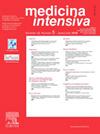脓毒症患者持续性AKI的评价中钠钾分数排泄与尿强离子的差异
IF 3.1
4区 医学
Q2 CRITICAL CARE MEDICINE
引用次数: 0
摘要
目的评价FENa(分数排泄钠)、FEK(分数排泄钾)和uSID(尿强离子差)对pAKI在脓毒症和感染性休克中的诊断价值。设计回顾性队列研究。阿根廷的两个重症监护室。患者确诊为脓毒症或脓毒性休克合并AKI的成年患者,并在AKI诊断后24小时内进行尿生化检查。干预措施:主要感兴趣的变量我们通过ROC(受试者工作特征)曲线分析评估FENa、FEK和uSID的诊断准确性。结果共纳入80例患者。40例患者出现pAKI。pAKI组APACHE评分、SOFA评分及死亡率较高。在ROC曲线分析中,uSID没有诊断价值(AUC = 0.52, p = 0.69)。FENa准确度中等,AUC为0.71 (95% CI 0.60 ~ 0.83;p = 0.001),而FEK的准确度较低,AUC为0.69 (95% CI 0.57−0.80;p = 0.04)。诊断pAKI的最佳约登点为FENa大于0.51%,特异性为72.5%,敏感性为65.0%。FEK的特异度为67.5%,敏感性为65.0%,特异度高于21.9%时相关性最佳。结论脓毒症患者的尿生化解释必须修订。FENa和FEK与AKI的严重程度有关,可作为诊断pAKI的辅助工具。本文章由计算机程序翻译,如有差异,请以英文原文为准。
Fractional excretion of sodium and potassium and urinary strong ion difference in the evaluation of persistent AKI in sepsis
Objective
To evaluate the diagnostic performance of FENa (Fractional excretion of sodium), FEK (fractional excretion of potassium) and uSID (urinary strong ion difference) in predicting pAKI in sepsis and septic shock.
Design
Retrospective cohort study.
Setting
Two intensive care units in Argentina.
Patients
Adult patients with a confirmed diagnosis of sepsis or septic shock and AKI, and had a urinary biochemistry within 24 h of the AKI diagnosis.
Interventions
None.
Main variables of interest
We evaluated the diagnostic accuracy of FENa, FEK and uSID through a ROC (Receiver Operating Characteristic) curve analysis.
Results
80 patients were included. 40 patients presented pAKI. pAKI group had higher APACHE, SOFA score, and mortality rate. In the ROC curve analysis, uSID had no diagnostic utility (AUC = 0.52, p = 0.69). FENa presented moderate accuracy showing an AUC of 0.71 (95% CI 0.60−0.83; p = 0.001), while FEK presented low accuracy with an AUC of 0.69 (95% CI 0.57−0.80; p = 0.04). The optimal Youden point for identifying pAKI was at a FENa higher than 0.51 % with a specificity of 72.5% and a sensitivity of 65.0%. In the case of FEK, a value higher than 21.9 % presented the best relation, with a specificity of 67.5% and a sensitivity of 65.0%.
Conclusions
urine biochemistry interpretation in septic patients must be revised. FENa and FEK are related to the severity of AKI and could be helpful complementary tools for diagnosing pAKI.
求助全文
通过发布文献求助,成功后即可免费获取论文全文。
去求助
来源期刊

Medicina Intensiva
CRITICAL CARE MEDICINE-
CiteScore
2.70
自引率
20.00%
发文量
146
审稿时长
33 days
期刊介绍:
Medicina Intensiva is the journal of the Spanish Society of Intensive Care Medicine and Coronary Units (SEMICYUC) and of Pan American and Iberian Federation of Societies of Intensive and Critical Care Medicine. Medicina Intensiva has become the reference publication in Spanish in its field. The journal mainly publishes Original Articles, Reviews, Clinical Notes, Consensus Documents, Images, and other information relevant to the specialty. All works go through a rigorous selection process. The journal accepts submissions of articles in English and in Spanish languages. The journal follows the publication requirements of the International Committee of Medical Journal Editors (ICMJE) and the Committee on Publication Ethics (COPE).
 求助内容:
求助内容: 应助结果提醒方式:
应助结果提醒方式:


